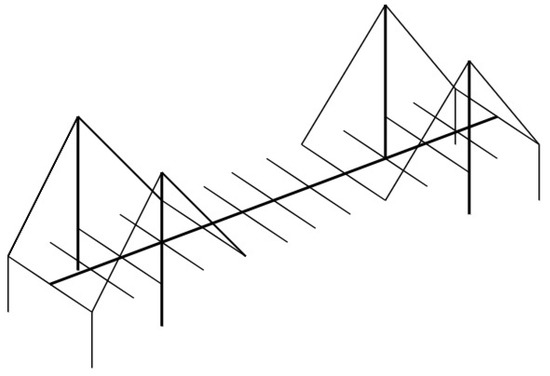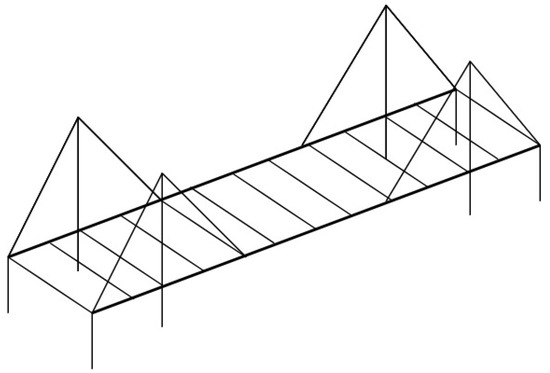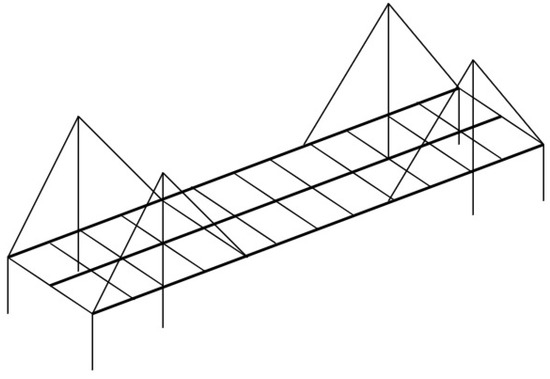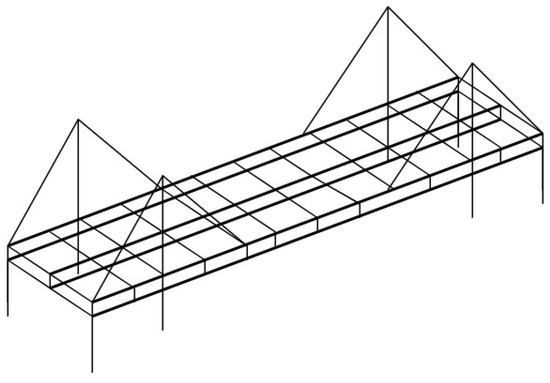Finite element (FE) model updating is a well-recognised approach for Structural Health Monitoring (SHM) purposes, as an accurate model serves as a baseline reference for damage detection and long-term monitoring efforts. One of the many challenges is the development of the initial FE model that can accurately reflect the dynamic characteristics and the overall behaviour of a bridge. Given the size, slenderness, use of long cables, and high levels of structural redundancy, precise initial models of long-span cable-stayed bridges are desirable to better facilitate the model updating process and to improve the accuracy of the final updated model. To date, very few studies offer in-depth discussions on the modelling approaches for cable-stayed bridges and the methods used for model updating. As such, this article presents the latest advances in finite element modelling and model updating methods that have been widely adopted for cable-stayed bridges, through a critical literature review of existing research work.
- cable-stayed bridge
- structural health monitoring
- finite element modelling
- model updating
1. Finite Element Modelling of Cable-Stayed Bridges
1.1. General Bridge Modelling Approaches
1.2. Cable-Stayed Bridge Modelling Approaches
1.2.1. Single-Girder Modelling

1.2.2. Double-Girder Modelling

1.2.3. Triple-Girder Modelling

1.2.4. Multi-Scale Modelling

2. Finite Element Model Updating of Cable-Stayed Bridges
2.1. Overview of Model Updating Methods
Discrepancies inevitably exist between the computed numerical model results and the measured behaviour of the structure. FE model updating (FEMU), which seeks to correct the initial FE model errors, has been widely applied to obtain an updated model that can accurately reflect its real-world counterpart. FEMU can be described as an inverse problem, i.e., the process of calculating, from a set of observations, the required factors or parameters that produced these observations. On this basis, FEMU methods are broadly categorised into direct, iterative, and stochastic methods.
2.1.1. Direct Methods
Direct FEMU methods aim to update the mass and stiffness matrices in a single-step finite element procedure. While direct methods are computationally efficient, most literatures reported their applications to experimental or analytical studies of structures only [41][42][43][44], as the matrices have lost the physical meaning after updating.
2.1.2. Iterative Methods
Iterative FEMU methods are known as deterministic parameter updating methods as the parameters of the FE model are modified iteratively to minimise the differences between the measurements and the analytical predictions. Compared to direct methods, iterative methods can achieve more reliable results, as the physical meaning is maintained after updating, and therefore make up the bulk of the literature on model updating of large civil engineering structures such as cable-stayed bridges. Iterative methods are generally formulated around the minimisation of the differences between the measured behaviour and the model predictions (usually natural frequencies) in the form of an objective function. The minimisation of this objective function proceeds iteratively by generating a sequence of solutions, each of which represents an improved approximation of the parameter values. Furthermore, the sensitivity and selection of parameters for updating have an important influence of the effectiveness of the method. As such, iterative FEMU methods are also broadly referred to as sensitivity-based updating [45][46]. The limitations of iterative methods lie in that they do not consider the factor of noise and long-term variation that exist in the measurements. As such, the single value parameter estimates determined by iterative methods may not represent the entire set of possible solutions to the updating problem.
2.1.3. Stochastic Methods
Stochastic FEMU methods generally utilise Bayes’ theorem to estimate a posterior probability density function of the model parameters to be updated. This requires defining a prior probability density function which reflects the initial assumptions or knowledge of the parameters prior to any measurements, and a likelihood probability density function which describes the degree of agreement between the FE model and the measured data. Due to its complexity, model updating using Bayes’ theorem, or Bayesian updating, requires data sampling techniques for implementation such as Transitional Markov Chain Monte Carlo (TMCMC), Metropolis-Hasting Markov Chain Monte Carlo (MH-MCMC), and Hamiltonian Monte Carlo (HMC). Bayesian updating applications to bridges include those by Asadollahi et al. [32] who updated a cable-stayed bridge using TMCMC, Pepi et al. [47] who sampled data using MH-MCMC for updating a cable-stayed footbridge, Baisthakur and Chakraborty [48] who developed a modified HMC algorithm for updating a steel truss bridge, and Mao et al. [49] who conducted Bayesian updating of a suspension bridge using HMC sampling. Although stochastic updating methods present the advantage of taking uncertainty and data variability into account, its computational expense is very high compared to other methods.
2.1.4. Computational Intelligence Methods
Computational intelligence FEMU methods utilise both deterministic iterative methods and stochastic methods in conjunction with computational intelligence techniques to facilitate the updating process. The principle techniques include optimisation-based methods, machine learning methods, and evolutionary algorithms. Marwala [50] covered a range of computational intelligence-based model updating techniques for comparison purposes, including Genetic Algorithm (GA), Particle-Swarm Optimisation (PSO), Simulated Annealing, Response-Surface Method, Artificial Neural Networks (ANN), a Bayesian approach, and hybrid methods combining the abovementioned methods. Hybrid methods were shown to be the most accurate, which is confirmed by the following researchers. Deng and Cai [51] used a combined response surface method and genetic algorithm to update a cantilever test bridge. Jung and Kim [52] utilised a hybrid genetic algorithm for updating a small-scale bridge. Astroza et al. [53] proposed a hybrid global optimisation algorithm combining simulated annealing and unscented Kalman filter for steel frame structures. Tran-Ngoc et al. [54] used the particle swarm optimisation and genetic algorithm to update the Nam O arch bridge in Vietnam. More recently, Nguyen et al. [55] investigated hybrid updating for building deterioration assessment and Naranjo-Pérez et al. [56] proposed a collaborative algorithm combing optimisation algorithms alongside ANN.
2.2. Model Updating in the Literature
The literature demonstrates a recent shift away from deterministic model updating methods to stochastic and computational intelligence methods, as developments in long-term, SHM with on-structure sensors have contributed to big data issues that require statistical analysis. As such, the literature trend shows that modelling and model updating are increasing in computational complexity on the assumption that this complexity increases accuracy and/or decreases uncertainty. However, this assumption has shown to be not always correct. Asadollahi et al. [32] presented the most recent and detailed example of Bayesian model updating for a long-span cable-stayed bridge. While the FE model parameters and measurement uncertainties were fully considered thus demonstrating the strength of the Bayesian approach, there are notable limitations in the accuracy of the updated model with the largest difference after updating being 31%. Similarly, Wang et al. [57], when updating a multi-scale model of a cable-stayed bridge, presented a multi-objective optimisation evolutionary algorithm which considered both global and local objective functions. For a computationally intensive updating method, the updated model accuracy barely improved and for many modes, worsened.
The strength of stochastic model updating methods, in particular the increasing popularity of Bayesian inference in dealing with uncertainties, have been well documented [58][59][60]. In parallel with Bayesian applications, criticisms of its computational expense have also been well documented. As first indicated by Trucano et al. [61], the prior distributions of Bayesian updating parameters are difficult to specify, and the subjectivity introduced when specifying prior distributions can lead to unstable posterior results [62]. Ma et al. [63] highlighted that directly applying Markov Chain Monte Carlo samplers to solve stochastic FE model updating is inefficient because the samplers are prone to stopping at local minima. Furthermore, the complexity in problem solutions, as well as the requirement for high computational costs, also restrains applications of Bayesian updating methods to complex problems. As computational efficiency is a major issue, and the large number of elements and parameters in cable-stayed bridge FE models make them difficult to update directly, the metamodels have been utilised to alleviate this problem. The response surface method [64][65], neural networks [66][67], Kriging model [68][69], and stochastic expansion methods [70][71] have been the focus of research in this area, yet few of these have been applied to cable-stayed bridges.
Another aspect of FE model updating that is limited in the literature is determining modal properties from a limited number of on-structure sensors and the challenges this presents when performing model updating task. Most bridges will not be fitted with extensive SHM sensor networks due to cost restraints and will rely on a limited number of strategically placed sensors for monitoring. While recent research has focused on data-driven algorithms from comprehensive SHM systems, little attention has been given to limited or minimal sensor networks and what value can be derived from them in conjunction with FE models.
01+(ρL)2E012σ3This entry is adapted from the peer-reviewed paper 10.3390/infrastructures7010008
References
- Hambly, E.C. Bridge Deck Behaviour; CRC Press: Boca Raton, FL, USA , 1991.
- Kanok-Nukulchai, W.; Yiu, P.K.A.; Brotton, D.M. Mathematical modelling of cable-stayed bridges. Struct. Eng. Int. 1992, 2, 108–113.
- Walther, R. Cable Stayed Bridges; Thomas Telford Ltd: London, UK , 1999.
- Fu, C.C.; Wang, S. Computational Analysis and Design of Bridge Structures; CRC Press: Boca Raton, FL, USA, 2014.
- Adams, A.; Galindez, N.; Hopper, T.; Murphy, T.; Ritchie, P.; Storlie, V.; Weisman, J. Manual for Refined Analysis in Bridge Design and Evaluation; United States, Federal Highway Administration, Office of Infrastructure: Washington, DC, USA, 2019.
- Xu, Y.-L. Wind Effects on Cable-Supported Bridges; John Wiley & Sons: Hoboken, NJ, USA, 2013.
- Xu, Y.-L.; Xia, Y. Structural Health Monitoring of Long-Span Suspension Bridges; CRC Press: Oxford, UK, 2011.
- Xu, Y.; Ko, J.; Zhang, W. Vibration studies of Tsing Ma suspension bridge. J. Bridge Eng. 1997, 2, 149–156.
- Ernst, J. Der E-Modul von Seilen unter berucksichtigung des Durchhanges. Der Bauing. 1965, 40, 52–55.
- Gazzola, F. Mathematical Models for Suspension Bridges; Springer: Berlin/Heidelberg, Germany , 2015.
- Bas, S. Structural Identification (St-Id) Concept for Performance Prediction of Long-Span Bridges. In Bridge Engineering; IntechOpen: London, UK, 2017.
- Pipinato, A. Innovative Bridge Design Handbook: Construction, Rehabilitation and Maintenance; Butterworth-Heinemann: Oxford, UK, 2015.
- Ereiba, H. The Dynamic Behaviour of Cable-Stayed Bridges; University of Sheffield: Sheffield, UK, 1980.
- Zhang, S. The Finite Element Analysis of Thin-Walled Box Spine-Beam Bridges; City University London: London, UK, 1982.
- Wilson, J.C.; Gravelle, W. Modelling of a cable‐stayed bridge for dynamic analysis. Earthq. Eng. Struct. Dyn. 1991, 20, 707–721.
- Yiu, P.; Brotton, D. Mathematical modelling of cable-stayed bridges for computer analysis. Presented at the International Conference on Cable-Stayed Bridges, Bangkok, Thailand, 18–20 November 1987 .
- Cheng, S.; Han, D-J.; Wang, L.W. The establishment of 3-D finite element dynamic models for long-span cable-stayed bridges. J. South China Univ. Technol. Nat. Sci. 1999, 27, 51–56.
- Zhu, L.; Xiang, H.; Xu, Y. Triple-girder model for modal analysis of cable-stayed bridges with warping effect. Eng. Struct. 2000, 22, 1313–1323.
- Brownjohn, J.M.W.; Lee, J.; Cheong, B. Dynamic performance of a curved cable-stayed bridge. Eng. Struct. 1999, 21, 1015–1027.
- Ren, W.-X.; Peng, X.-L. Baseline finite element modeling of a large span cable-stayed bridge through field ambient vibration tests. Comput. Struct. 2005, 83, 536–550.
- Ding, Y.; Li, A.; Du, D.; Liu, T. Multi-scale damage analysis for a steel box girder of a long-span cable-stayed bridge. Struct. Infrastruct. Eng. 2010, 6, 725–739.
- Dyke, S.J.; Caicedo, J.M.; Turan, G.; Bergman, L.A.; Hague, S. Phase I benchmark control problem for seismic response of cable-stayed bridges. J. Struct. Eng. 2003, 129, 857–872.
- Caicedo, J.; Dyke, S.; Turan, G.; Bergman, L. Comparison of modeling techniques for dynamic analysis of a cable-stayed bridge. Presented at the Engineering Mechanics Conference, ASCE, Austin, TX, USA, 21–24 May 2000 ; pp. 21–23.
- Schemmann, A.G.; Smith, H.A. Vibration control of cable‐stayed bridges—Part 1: Modeling issues. Earthq. Eng. Struct. Dyn. 1998, 27, 811–824.
- Caetano, E.; Cunha, A.; Taylor, C.A. Investigation of dynamic cable–deck interaction in a physical model of a cable‐stayed bridge. Part I: Modal analysis. Earthq. Eng. Struct. Dyn. 2000, 29, 481–498.
- Wu, Q.; Takahashi, K.; Okabayashi, T.; Nakamura, S. Response characteristics of local vibrations in stay cables on an existing cable-stayed bridge. J. Sound Vib. 2003, 261, 403–420.
- Chang, C.; Chang, T.; Zhang, Q. Ambient vibration of long-span cable-stayed bridge. J. Bridge Eng. 2001, 6, 46–53.
- Song, W.; Giraldo, D.; Clayton, E.; Dyke, S.; Caicedo, J. Application of ARMAV for modal identification of the Emerson Bridge. Presented at the Third international conference on bridge maintenance, safety and management, Porto, Portugal, 16–19 July 2006 .
- Domaneschi, M.; Limongelli, M.P.; Martinelli, L. Damage detection and localization on a benchmark cable-stayed bridge. Earthq. Struct. 2015, 8, 1113–1126
- Lin, Y.Y.; Lieu, Y.L. Geometrically nonlinear analysis of cable‐stayed bridges subject to wind excitations. J. Chin. Inst. Eng. 2003, 26, 503–511.
- Nazmy, A.S.; Abdel‐Ghaffar, A.M. Non‐linear earthquake‐response analysis of long‐span cable‐stayed bridges: Theory. Earthq. Eng. Struct. Dyn. 1990, 19, 45–62.
- Asadollahi, P.; Huang, Y.; Li, J. Bayesian finite element model updating and assessment of cable-stayed bridges using wireless sensor data. Sensors 2018, 18, 3057.
- Torkamani, M.A.; Lee, H.E. Dynamic behavior of steel deck tension-tied arch bridges to seismic excitation. J. Bridge Eng. 2002, 7, 57–67.
- Hu, J.; Harik, I.E.; Smith, S.W.; Gagel, J.; Campbell, J.E.; Graves, R.C. Baseline Modeling of the Owensboro Cable-Stayed Bridge over the Ohio River; University of Kentucky Transportation Center: Lexington, KY, USA , 2006.
- Ren, W.-X.; Zhao, T.; Harik, I.E. Experimental and analytical modal analysis of steel arch bridge. J. Struct. Eng. 2004, 130, 1022–1031.
- Park, W.; Kim, H.-K.; Park, J.-C. Finite element model updating for a cable-stayed bridge using manual tuning and sensitivity-based optimization. Struct. Eng. Int. 2012, 22, 14–19.
- Brownjohn, J.M.W.; Xia, P.-Q.; Hao, H.; Xia, Y. Civil structure condition assessment by FE model updating:: Methodology and case studies. Finite Elem. Anal. Des. 2001, 37, 761–775.
- Macdonald, J.H.; Daniell, W.E. Variation of modal parameters of a cable-stayed bridge identified from ambient vibration measurements and FE modelling. Eng. Struct. 2005, 27, 1916–1930.
- Zhong, R.; Zong, Z.; Niu, J.; Liu, Q.; Zheng, P. A multiscale finite element model validation method of composite cable-stayed bridge based on Probability Box theory. J. Sound Vib. 2016, 370, 111–131.
- Abozeid, E.H.; Fayed, M.; Mourad, S.; Khalil, A. Cable-Stayed Bridge Model Update using Dynamic Measurements. Presented at the International Conference on Bridge Management Systems-Monitoring, Assessment and Rehabilitation, Giza, Egypt, 21–23 March, 2006 .
- Kanev, S.; Weber, F.; Verhaegen, M. Experimental validation of a finite-element model updating procedure. J. Sound Vib. 2007, 300, 394–413.
- Yuan, Z.X.; Yu, K.P. Finite element model updating of damped structures using vibration test data under base excitation. J. Sound Vib. 2015, 340, 303–316.
- Rezaiee‐Pajand, M.; Entezami, A.; Sarmadi, H. A sensitivity‐based finite element model updating based on unconstrained optimization problem and regularized solution methods. Struct. Control. Health Monit. 2020, 27, e2481.
- Chhipa, S.M.; Kumar, P.; Bagha, A.K.; Bahl, S. Removing uncertainty in the boundary condition of five degree of freedom spring mass vibratory system using direct updating method. Mater. Today Proc. 2021, 41, 251–255.
- Friswell, M.; Mottershead, J.E. Finite Element Model Updating in Structural Dynamics; Kluwer Academic Publishers: Dordrecht, The Netherlands, 1995; Volume 38.
- Mottershead, J.E.; Link, M.; Friswell, M.I. The sensitivity method in finite element model updating: A tutorial. Mech. Syst. Signal Process. 2011, 25, 2275–2296.
- Pepi, C.; Gioffré, M.; Grigoriu, M.D.; Matthies, H.G. Bayesian updating of cable stayed footbridge model parameters using dynamic measurements. Presented at the 7th ECCOMAS Thematic Conference on Computational Methods in Structural Dynamics and Earthquake Engineering, Crete, Greece, 24–26 June 2019; pp. 330–342.
- Baisthakur, S.; Chakraborty, A. Modified Hamiltonian Monte Carlo‐based Bayesian finite element model updating of steel truss bridge. Struct. Control. Health Monit. 2020, 27, e2556.
- Mao, J.; Wang, H.; Li, J. Bayesian Finite Element Model Updating of a Long-Span Suspension Bridge Utilizing Hybrid Monte Carlo Simulation and Kriging Predictor. KSCE J. Civ. Eng. 2020, 24, 569–579.
- Marwala, T. Finite Element Model Updating Using Computational Intelligence Techniques: Applications to Structural Dynamics; Springer Science & Business Media: Berlin/Heidelberg, Germany , 2010.
- Deng, L.; Cai, C. Bridge model updating using response surface method and genetic algorithm. J. Bridge Eng. 2010, 15, 553–564.
- Jung, D.-S.; Kim, C.-Y. Finite element model updating on small-scale bridge model using the hybrid genetic algorithm. Struct. Infrastruct. Eng. 2013, 9, 481–495.
- Astroza, R.; Nguyen, L.T.; Nestorović, T. Finite element model updating using simulated annealing hybridized with unscented Kalman filter. Comput. Struct. 2016, 177, 176–191.
- Tran-Ngoc, H.; Khatir, S.; De Roeck, G.; Bui-Tien, T.; Nguyen-Ngoc, L.; Abdel Wahab, M. Model updating for Nam O bridge using particle swarm optimization algorithm and genetic algorithm. Sensors 2018, 18, 4131.
- Nguyen, A.; Kodikara, K.T.L.; Chan, T.H.; Thambiratnam, D.P. Deterioration assessment of buildings using an improved hybrid model updating approach and long-term health monitoring data. Struct. Health Monit. 2019, 18, 5–19.
- Naranjo-Pérez, J.; Infantes, M.; Jiménez-Alonso, J.F.; Sáez, A. A collaborative machine learning-optimization algorithm to improve the finite element model updating of civil engineering structures. Eng. Struct. 2020, 225, 111327.
- Wang, F.-Y.; Xu, Y.-L.; Sun, B.; Zhu, Q. Updating multiscale model of a long-span cable-stayed bridge. J. Bridge Eng. 2018, 23, 04017148.
- Ching, J.; Chen, Y.-C. Transitional Markov chain Monte Carlo method for Bayesian model updating, model class selection, and model averaging. J. Eng. Mech. 2007, 133, 816–832.
- Cheung, S.H.; Beck, J.L. Bayesian model updating using hybrid Monte Carlo simulation with application to structural dynamic models with many uncertain parameters. J. Eng. Mech. 2009, 135, 243–255.
- Behmanesh, I.; Moaveni, B.; Lombaert, G.; Papadimitriou, C. Hierarchical Bayesian model updating for structural identification. Mech. Syst. Signal Process. 2015, 64, 360–376.
- Trucano, T.G.; Swiler, L.P.; Igusa, T.; Oberkampf, W.L.; Pilch, M. Calibration, validation, and sensitivity analysis: What's what. Reliab. Eng. Syst. Saf. 2006, 91, 1331–1357.
- Aughenbaugh, J.M.; Herrmann, J.W. Updating uncertainty assessments: A comparison of statistical approaches. Presented at the International Design Engineering Technical Conferences and Computers and Information in Engineering Conference, Las Vegas, NV, USA, 4–7 September 2007 ; pp. 1195–1209.
- Ma, T.; Zhang, Y.; Huang, X. A novel approach for stochastic finite element model updating and parameter estimation. Proc. Inst. Mech. Eng. Part C J. Mech. Eng. Sci. 2014, 228, 3329–3342.
- Marwala, T. Finite-element-model Updating Using the Response-surface Method. In Finite-Element-Model Updating Using Computional Intelligence Techniques: Applications to Structural Dynamics; Springer: London, UK , 2010; pp. 103–125.
- Ren, W.-X.; Chen, H.-B. Finite element model updating in structural dynamics by using the response surface method. Eng. Struct. 2010, 32, 2455–2465.
- Yin, T.; Zhu, H.P. An efficient algorithm for architecture design of Bayesian neural network in structural model updating. Comput. ‐Aided Civ. Infrastruct. Eng. 2020, 35, 354–372.
- Sung, H.; Chang, S.; Cho, M. Efficient Model Updating Method for System Identification Using a Convolutional Neural Network. AIAA J. 2021, 59, 1–10, https://doi.org/10.2514/1.J059964 .
- Yang, X.; Guo, X.; Ouyang, H.; Li, D. A Kriging model based finite element model updating method for damage detection. Appl. Sci. 2017, 7, 1039.
- Qin, S.; Zhou, Y.-L.; Cao, H.; Wahab, M.A. Model updating in complex bridge structures using kriging model ensemble with genetic algorithm. KSCE J. Civ. Eng. 2018, 22, 3567–3578.
- Adhikari, S.; Friswell, M. Distributed parameter model updating using the Karhunen–Loève expansion. Mech. Syst. Signal Processing 2010, 24, 326–339.
- Huang, B.; Chen, H. A new approach for stochastic model updating using the hybrid perturbation-Garlekin method. Mech. Syst. Signal Processing 2019, 129, 1–19.
